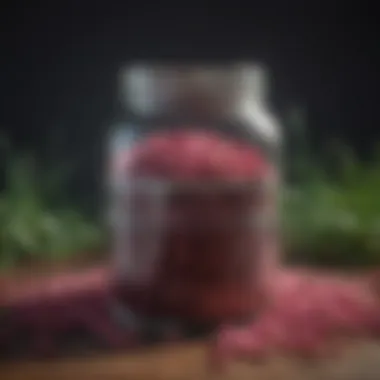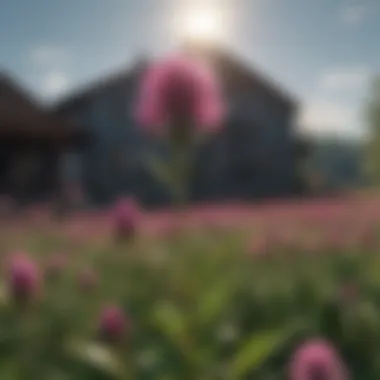Exploring Red Clover Pricing Dynamics and Trends


Intro
Understanding red clover pricing dynamics requires a clear comprehension of key concepts and the underlying variables that drive this market. Red clover, known scientifically as Trifolium pratense, serves various purposes, including livestock forage, soil improvement, and as a component in cover cropping systems.
This article seeks to dissect how historical trends, current market behaviors, and potential future changes shape the pricing of red clover. A thorough investigation into these areas allows farmers, buyers, and researchers to make more informed decisions, enhancing their strategic planning and agricultural practices.
Key Concepts and Terminology
Definition of Terms
In discussing red clover pricing, it helps to understand the following terms:
- Market Dynamics: Refers to the forces that impact the supply and demand for red clover, influencing its price.
- Price Elasticity: The measure of how much the quantity demanded changes in response to price changes. For red clover, this can vary based on market conditions and consumer preferences.
- Supply Chain: Encompassing all processes that contribute to the growth, harvest, and distribution of red clover, shifts in this area significantly affect pricing.
Overview of Relevant Practices
Practices affecting red clover pricing include:
- Cultivation Techniques: Methods of planting and harvesting can influence yield, which in turn affects market availability and pricing.
- Market Demand Analysis: Understanding who needs red clover, from livestock owners to agronomists, allows stakeholders to predict price movements.
Utilizing these definitions and practices, stakeholders can approach red clover pricing with an analytical lens.
Current Trends and Innovations
Latest Research and Developments
As the agriculture industry evolves, several trends impact red clover prices. Recent studies show:
- Increased interest in sustainable agriculture has led to a rise in red clover cultivation for its environmental benefits, such as nitrogen fixation.
- Research into variety improvements shows promise in enhancing yield and resilience, directly influencing supply and price.
Emerging Technologies and Tools
Technological advancements are also shaping the red clover market. These include:
- Precision Agriculture: Techniques that utilize data analytics to optimize crop yield are becoming more common, leading to more efficient red clover production.
- Drone Technology: Drones are being used to monitor crop health, allowing for timely interventions that can preserve yield and stabilize prices.
Practical Applications
Step-by-Step Guides
For stakeholders looking to optimize their approach to red clover production and pricing:
- Research Local Market: Study historical pricing data and current demand trends in your area.
- Evaluate Cultivation Techniques: Consider different methods that might improve yield or reduce costs.
- Monitor Supply Chain: Stay aware of any disruptions that may impact your ability to deliver red clover to buyers.
Troubleshooting Common Issues
Should challenges arise:
- If you experience low yield, assess soil quality and moisture levels.
- In case of fluctuating prices, keep an eye on market news and adjust your sales strategy accordingly.
By staying informed about key terms, current trends, and practical applications, stakeholders can navigate the complexities of red clover pricing more effectively.
This exploration of red clover pricing dynamics aims to assist all agricultural stakeholders in adapting to future market challenges and opportunities.
Preamble to Red Clover
Red clover, a species of flowering plant from the legume family, plays a pivotal role in modern agriculture. Its significance extends beyond mere cultivation. Understanding red clover encompasses recognizing its contributions to soil health, livestock nutrition, and agricultural economics.
Agricultural stakeholders must pay attention to red clover for several reasons. First, its ability to fix nitrogen in the soil enhances fertility. This characteristic makes it an essential component in crop rotation systems, providing benefits to both immediate and subsequent crops. Second, red clover serves as an excellent forage crop. It supports livestock diets, increasing the efficiency of animal production. Finally, the economic aspect cannot be overlooked as red clover pricing dynamics can deeply affect farmers' choices, from planting decisions to market strategies.


The analysis of red clover agriculture begins with an examination of its botanical characteristics and agricultural uses. These elements set a foundation for the subsequent pricing discussion and help in understanding farm-level decision-making.
Botanical Characteristics
Red clover (Trifolium pratense) is identifiable by its compound leaves and purple flowers. The plant typically grows between 12 to 36 inches tall. It thrives in well-drained soils with adequate moisture. Its deep root system allows it to withstand drought conditions better than other forage crops.
The flowers of red clover are not only visually appealing but also attract various pollinators, contributing to biodiversity in agricultural settings. The plant can be used as a perennial crop, providing ground cover for several years, thereby reducing soil erosion. The robust nature of red clover makes it suitable for both production and ecological purposes.
Uses of Red Clover in Agriculture
Red clover serves multiple functions in modern agricultural practices. It is primarily used as:
- Forage Crop: Red clover is highly nutritious and is often mixed with grasses, enhancing forage quality for livestock.
- Cover Crop: Farmers utilize it to improve soil structure and health during offseasons, benefiting subsequent planting activities.
- Erosion Control: Due to its dense growth habit, it prevents soil erosion on slopes and during heavy rains.
In addition to these uses, red clover’s economic value is noteworthy. With rising demand for sustainable and organic farming practices, its role continues to expand. The sustainable cultivation of red clover can align with environmentally sound farming strategies, making it an attractive option for today’s farmers.
Historical Context of Red Clover Pricing
The historical context of red clover pricing reveals much more than just numbers. Understanding the trajectory of red clover prices over time provides insights into agricultural practices, economic conditions, and market fluctuations. This context is important for farmers deciding whether to invest in red clover cultivation. It also helps buyers to make informed purchasing decisions, and researchers to understand market behavior. By analyzing past price trends, we can glean information regarding future movements, which is valuable for all stakeholders in the agricultural sector.
Early Price Trends
In early agricultural history, red clover was primarily valued for its role as a forage crop. Historically, red clover prices were relatively stable, aligning closely with the overall demand for livestock feed. For instance, in the early 20th century, there was a marked increase in the cultivation of red clover in the United States due to its high protein content and soil fertility enhancement. During this period, prices remained low as the supply increased. However, a shift occurred post-World War II when agricultural intensification saw a rise in demand for clover as a pivotal component in mixed cropping systems. Consequently, this demand began to exert upward pressure on prices.
Economic Events Impacting Prices
Various economic events have had significant impacts on red clover prices throughout the decades. Economic trends, such as the Great Depression in the 1930s, caused prices to plummet due to decreased purchasing power among farmers. Furthermore, policy changes, like the introduction of agricultural subsidies in the 1960s and 1970s, also altered the pricing dynamics. These subsidies facilitated the price increases by enabling farmers to expand their crop production.
"Market interventions like subsidies can dramatically shift supply levels, affecting prices for crops like red clover."
In more recent years, global events such as trade agreements and foreign market fluctuations have further influenced prices. For example, the introduction of the North American Free Trade Agreement (NAFTA) in 1994 led to increased competitiveness for U.S. farmers in relation to their Canadian and Mexican counterparts, impacting overall market prices. Understanding these economic events helps stakeholders predict how similar occurrences may affect red clover prices in the future.
Current Red Clover Price Analysis
Understanding the current price dynamics of red clover is pivotal for several reasons. This section zeroes in on the way prices are established today amidst varying market influences. Monitoring market prices grants farmers, traders, and researchers a grasp on lucrative opportunities, optimal timing for sales, and insights for strategic decision-making. Given the fluctuations in agricultural commodities, grasping these pricing mechanisms brings significant benefits, especially when considering cost margins and sourcing decisions.
Market Pricing Mechanisms
The price of red clover is influenced by a variety of market mechanisms. These mechanisms can be broadly classified into factors affecting demand, supply, and external variables.
- Supply Factors: Production levels have a direct impact on prices. In years of abundant harvests due to favorable weather, prices typically tend to decrease. Conversely, poor crop yields can push prices upwards due to scarcity. In this case, prices can be subject to rapid change based on simply how well the crops flourish.
- Demand Dynamics: The demand from specific sectors, such as livestock feed industries, plays a critical role. Rising interest in sustainable farming methods has bolstered the demand for red clover, particularly because of its beneficial nutrient profile for livestock. As such, increased demand generally leads to price hikes.
- Market Structures: Red clover transactions often take place through a network of farmers, distributors, and retailers. Each of these players adds their layer of markup. Clearly, understanding these roles can clarify the pricing trends observed.
- Global Trends: International trade also influences local prices. If there are shifts in global markets—like changes from countries such as Canada or Australia—it can ripple through to domestic prices.
Regional Price Variations
Price variances are often evident when viewing the regional markets for red clover. Geographic location significantly dictates pricing due to many factors: shipping costs, local demand, and regional agricultural practices.
- Geographic Influences: Farmers in the Midwest USA might see a different pricing structure than those in the Southeast due to cropped land productivity and soil quality scenarios.
- Transportation Costs: Proximity to markets affects cost efficiency for producers. Regions closer to major urban centers may witness higher prices as demand grows, juxtaposing areas that are further afield.
- Local Regulations: Each region has unique agricultural policies and support regulations which can also contribute to price variability. For instance, states offering subsidies for certain crops might experience inflated price structures due to supply incentives.
Pricing Comparisons with Other Legumes
When analyzing red clover pricing, it is insightful to compare it with prices of other legumes such as alfalfa or clover varieties. This comparison provides context about its market stature.
- Market Positioning: Generally, red clover's market value tends to be lower than alfalfa due to its growth characteristics and the duration to maturity. Alfalfa is often the preferred choice for many livestock feed operations, resulting in higher prices.
- Nutritional Profile: Interestingly, while red clover may be cheaper, it offers unique nutritional benefits that some farmers may find more desirable depending on their specific feeding strategies.
- Price Trends: As a market comparison, regularly tracking historical pricing data of these legumes can reveal insights about shifting preferences and economic viability. If red clover prices begin to outpace those of alfalfa, it may indicate a shift in farming practices or consumer preferences.
In sum, comprehensively analyzing current red clover prices is crucial in ensuring all stakeholders can navigate the complexities of the market landscape efficiently. Recognizing market pricing mechanisms, regional price variations, and comparative pricing insights facilitates informed decision-making in red clover cultivation and trading.
Factors Influencing Red Clover Prices
Understanding the factors influencing red clover prices is essential for stakeholders in the agricultural sector. Prices fluctuate due to a combination of supply dynamics, demand from other industries, and environmental changes. Addressing these elements helps farmers, buyers, and researchers make informed decisions regarding cultivation and trade of red clover.


Agricultural Output and Supply
Agricultural output plays a significant role in determining red clover prices. When supply increases, prices typically decrease, while a reduced output can lead to higher prices. Various factors affect how much red clover is produced, including:
- Soil Health: Healthy soils yield better crops. Farmers must engage in practices that improve soil nutrients to achieve optimal output.
- Crop Rotation: Planting red clover in a strategic rotation can enhance overall yields and maintain soil vitality. This practice not only increases demand but also ensures the land remains productive.
- Pest and Disease Management: Effective management practices minimize losses and secure consistent supply. A poor harvest due to pests can drive prices up considerably.
As output fluctuates, it is crucial for farmers to monitor their production practices carefully. This enables better adjustments to market conditions, helping manage costs effectively.
Demand from Livestock Feed Industry
The livestock feed industry is a primary consumer of red clover. Understanding the demand from this sector is vital for estimating potential price trends. Factors affecting this demand include:
- Livestock Numbers: An increase in livestock farming leads to higher demand for feed. If farmers raise more cattle or sheep, their need for red clover increases correspondingly.
- Nutritional Benefits: Red clover is a high-protein forage. Its benefits for livestock health promote its demand. Farmers benefit by knowing the nutritional advantages of red clover, ensuring their livestock maintains good health for productivity.
- Market Trends in Animal Products: Wider trends such as rising beef or dairy prices influence the demand for red clover. If prices for these products increase, livestock farmers invest more in high-quality feed.
Thus, awareness of livestock industry trends can significantly inform pricing strategies related to red clover.
Impact of Climate Change
Climate change continues to affect agricultural dynamics globally. Its influence on red clover pricing is significant. Here are some points to consider:
- Weather Variability: Changes in rainfall patterns can affect crop yield. Prolonged droughts or excessive rainfall can diminish red clover harvests, leading to price volatility.
- Growing Seasons: Climate change alters traditional growing seasons. If farmers shift planting schedules, this may create mismatches between supply and demand, affecting market pricing.
- Pest and Disease Proliferation: New climatic conditions can lead to the spread of pests and diseases not previously seen. This may result in increased crop losses, subsequently raising prices due to lower supply.
"Farmers must remain vigilant about climatic shifts, as this knowledge will be central to their long-term planning and pricing strategies."
With a clearer understanding of these influencing factors, stakeholders can better navigate the market environment and cultivate red clover effectively.
Economic Implications of Red Clover Pricing
Understanding the economic implications of red clover pricing is crucial for various stakeholders in the agricultural sector. As red clover plays a significant role in livestock feed and soil improvement, its pricing dynamics impact farmers, consumers, and regional economies. The following sections discuss the economic relevance of this topic, focusing on the costs and benefits for farmers and the broader influence on local economies.
Cost-Benefit Analysis for Farmers
For farmers, a detailed cost-benefit analysis of cultivating red clover is essential. This analysis goes beyond mere pricing to take into account factors such as production costs, market demand, and profitability.
Key Factors in Cost-Benefit Analysis:
- Production Costs: These include seed costs, fertilizers, labor, and other inputs required for cultivating red clover.
- Yield Estimates: Expected yields will affect the potential profitability. Farmers need to analyze historical data on yields to estimate future production.
- Market Prices: Farmers must monitor market prices for red clover, ensuring they can sell their product at a price that covers their costs and delivers profit.
- Substitutes Available: If farmers face competition from other feed crops, understanding the comparative advantages of red clover is necessary.
Analyzing these factors helps farmers make informed decisions regarding their cultivation practices and financial planning. This enables optimal resource allocation, ensuring that red clover remains a viable option in their crop rotation schemes.
Influence on Regional Economies
Red clover pricing does not only affect individual farmers; it has broader implications for regional economies. As red clover is a critical component in livestock feed, fluctuations in its price can influence the entire agricultural ecosystem.
Economic Impact Factors to Consider:
- Employment Opportunities: The cultivation and processing of red clover create jobs in rural communities, supporting local economies. When prices are high, more farmers may choose to grow it, potentially boosting employment.
- Supply Chain Effects: Price changes can ripple through the supply chain. Higher prices can encourage more efficient distribution and manufacturing processes, potentially benefiting the local economy.
- Export Potential: Regions that grow red clover might exploit foreign markets, expanding their economic horizon. As demand for sustainable livestock feed rises globally, regions producing high-quality red clover can enhance their export profiles.
Understanding the economic implications of red clover pricing helps stakeholders grasp the broader context of agricultural practices and market health.
Future Projections for Red Clover Prices
The future of red clover pricing is a vital topic in understanding both the agricultural landscape and market behavior. Prices can shift due to diverse factors like demand fluctuations, production costs, and government policies. Hence, having a clear view of future pricing trends enables farmers to make informed decisions about cultivation and investment.
Forecasting Price Trends
Forecasting price trends involves analyzing historical data, market conditions, and potential economic events. Experts often use statistical models to project how prices might evolve. Given the essential role red clover plays in livestock feed, any changes in the livestock industry directly impact red clover demand and pricing. For example, if livestock prices rise, it is likely that red clover prices will follow suit due to increased demand.
Some key factors that analysts consider include:


- Supply chain dynamics: Disruptions in production or logistics can significantly affect prices.
- Consumer preferences: If consumers prioritize sustainable practices, organic red clover may see a price increase relative to conventional options.
- Global market influences: International trade agreements and tariffs can play a crucial role in domestic prices.
"Understanding price trends is not just about numbers; it's about deciphering the patterns and signals in the market that guide investment and cultivation strategies."
Technological Impacts on Production Costs
Advances in technology can dramatically change production costs for red clover. For instance, improved seed varieties that are resistant to pests and diseases can lower the need for chemical inputs, contributing to more stable and potentially lower prices. Such developments not only benefit farmers but can also affect market prices positively.
Some technological innovations to consider include:
- Precision agriculture tools: These can enhance yield efficiency and reduce waste.
- Biotechnology: Genetic modifications can lead to stronger, more resilient crops.
- Data analytics: Farmers leveraging big data can optimize their practices, effectively reducing costs and improving yield.
Market Interventions and Policies
Understanding market interventions and policies is critical in the context of red clover pricing dynamics. Government actions can greatly influence market conditions. This section will examine the various regulations and support programs that shape the landscape of red clover production and pricing.
Government Regulations
Government regulations encompass various measures aimed at maintaining market stability and protecting local farmers. These regulations often dictate pricing models, trade barriers, and safety standards, all of which directly affect red clover prices.
For instance, legislation that supports sustainable farming practices can influence production levels. If the environment becomes more resilient due to better farming practices, the supply of red clover may increase. This could potentially lead to lower prices. On the other hand, stringent regulations on the use of pesticides and fertilizers may raise production costs, impacting prices positively for producers.
Some key aspects of government regulations include:
- Quality control standards: Ensure only high-quality red clover enters the market.
- Import tariffs: Can protect domestic farmers from foreign competition, affecting pricing.
- Subsidies: Offered for sustainable farming practices, can lower operational costs for farmers.
These regulations not only influence farmers but also impact other stakeholders in the supply chain. Understanding these dynamics is essential for professionals involved in red clover production and trade.
Support Programs for Farmers
Support programs are another crucial element in the discussion of red clover market dynamics. These programs may take various forms, from financial assistance to training in best practices.
Common types of support include:
- Financial grants: Assist farmers in upgrading equipment or investing in new technology.
- Educational programs: Educate farmers on crop rotation, soil health, and pest management.
- Research funding: Encourages innovations that can lead to more efficient production methods.
Such support helps to reduce the risks associated with farming. When farmers feel secure, they are more likely to invest in their operations, leading to increased production. Higher production can stabilize or even reduce prices, benefitting consumers and businesses alike.
Support programs thus serve as a safety net for farmers, helping them to navigate unpredictable market conditions and adapt to changes in demand.
Both government regulations and support programs play a vital role in shaping the red clover market. Policymakers and farm stakeholders must collaborate effectively to ensure that interventions lead to a sustainable and profitable agricultural environment.
Epilogue
In any thorough examination of red clover pricing dynamics, the conclusion plays a pivotal role. It ties together the various strands of the analysis, creating a coherent narrative that underscores the complexities and nuances of market behaviors. Understanding the conclusions drawn from the data and analysis is essential; they provide clarity on how historical trends and current market influences shape future projections.
Summary of Findings
The findings of the article reveal several key insights regarding red clover pricing. Firstly, historical pricing trends illustrate significant fluctuations driven by external economic factors. These have varied widely from regional agricultural practices to global economic shifts. The interplay between supply and demand also stands central. Increased interest in sustainable agriculture has heightened demand from the livestock feed industry, impacting price stability.
Secondly, the impact of climate change is critical. Changes in weather patterns affect crop yields, which subsequently influence market prices. Furthermore, technology in agriculture is beginning to reduce production costs, which may lead to more competitive pricing in the future.
Lastly, government interventions through support programs and regulations have shaped pricing structures. Such actions often aim to stabilize markets amidst fluctuating prices, ensuring that farmers remain viable.
Implications for Stakeholders
The implications of these findings are significant for various stakeholders in the agriculture sector. Farmers must evaluate their cultivation choices, considering pricing trends and economic support systems available. Utilizing the insights from the article can guide farmers in adapting their strategies to maximize profitability.
Buyers, particularly those in the livestock industry, should pay attention to these dynamics as well. Understanding price forecasts can aid in negotiating better terms and predicting market movements.
Lastly, researchers and policymakers must recognize the importance of these findings for planning interventions that support sustainable agricultural practices. The aim should always be to enhance efficiency and ensure fair pricing that benefits all parties involved.
"Analyzing the pricing dynamics of red clover gives crucial insights into both agricultural practices and market economics."
These insights establish a foundation for informed decision-making, not just in the present, but with an eye towards the future of red clover pricing.







